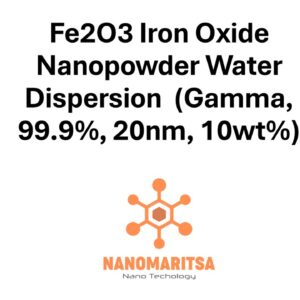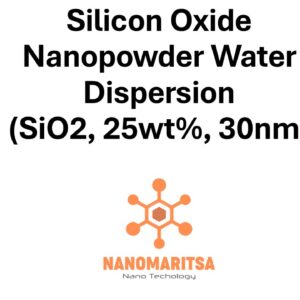Metal Oxide Dispersions
Titanium Oxide Nanopowder Water Dispersion (TiO2, Rutile, 40wt%, 30nm)
€90.00
CompareTitanium Oxide Nanopowder Water Dispersion (TiO₂, Rutile, 40 wt%, 30 nm) is a concentrated aqueous suspension of titanium dioxide nanoparticles in the rutile crystalline form. Here’s a detailed explanation:
1. Composition:
- Titanium Dioxide (TiO₂):
- A widely used material known for its optical, chemical, and thermal stability properties.
- Rutile Phase:
- The rutile crystalline structure offers:
- High refractive index for light-scattering applications.
- Exceptional thermal and chemical stability.
- Reduced photocatalytic activity compared to anatase, making it ideal for applications requiring durability.
- The rutile crystalline structure offers:
- Nanoparticles (30 nm):
- The average particle size is 30 nanometers, providing a high surface area for improved performance.
- 40 wt%:
- The dispersion contains 40% by weight of TiO₂ nanoparticles, offering a concentrated formulation with reduced water content.
- Water-Based Dispersion:
- The nanoparticles are uniformly dispersed in water, ensuring easy handling and application.
2. Key Properties:
- High Refractive Index:
- Excellent for UV protection, optical enhancement, and light-scattering applications.
- Thermal Stability:
- Withstands high temperatures without phase change, ensuring long-term performance.
- Hydrophilic Surface:
- Compatible with water-based systems and formulations.
- Concentrated Formulation:
- The 40 wt% concentration minimizes the amount of water, making it suitable for high-load applications.
- Low Photocatalytic Activity:
- The rutile phase reduces undesired oxidative reactions, enhancing durability.
- Particle Uniformity:
- Nanoparticles are evenly dispersed, preventing aggregation and ensuring consistent performance.
3. Applications:
- UV Protection:
- Used in sunscreens, cosmetics, and coatings to block harmful UV rays.
- Coatings:
- Enhances weather resistance, durability, and UV protection in architectural, automotive, and industrial coatings.
- Pigments:
- Provides whiteness, opacity, and brightness in paints, inks, and plastics.
- Photocatalysis:
- Effective in air and water purification systems, though less active than anatase-based TiO₂.
- Composites:
- Improves mechanical strength, thermal stability, and optical properties in polymer and ceramic composites.
- Energy Applications:
- Used in solar cells, photocatalytic reactors, and other energy-related technologies.
- Electronics:
- Functions as a dielectric material in electronic devices and optical layers in sensors.
4. Advantages:
- High Concentration:
- The 40 wt% dispersion offers more active material for high-efficiency applications.
- Rutile Stability:
- Ensures durability under UV and high-temperature conditions.
- Versatility:
- Suitable for a wide range of industrial, environmental, and cosmetic applications.
- Environmentally Friendly:
- Water-based dispersion avoids hazardous organic solvents.
- Ease of Use:
- Pre-dispersed and ready for immediate integration into various formulations.
5. Handling and Storage:
- Handling:
- Shake or stir thoroughly before use to ensure uniform nanoparticle distribution.
- Use protective gear (gloves, goggles) to avoid direct contact with the concentrated dispersion.
- Storage:
- Store in a cool, dry environment, away from direct sunlight and temperature extremes.
- Avoid freezing or prolonged exposure to high temperatures to maintain dispersion stability.
- Safety:
- While TiO₂ is generally safe, avoid inhalation of mist or prolonged skin and eye exposure.
Titanium Oxide Nanopowder Water Dispersion (TiO₂, Rutile, 40 wt%, 30 nm) is a high-performance, concentrated material designed for advanced applications in coatings, UV protection, composites, and energy systems. The rutile phase ensures stability and durability, while the nano size and high concentration enable enhanced performance in demanding environments.
SKU: MN07NPD0108
Category: Metal Oxide Dispersions
| Measurement (ml) | 100 ml, 500 ml, 1000 ml |
|---|
Related products
-
Metal Oxide Dispersions
Fe2O3 Iron Oxide Nanopowder Water Dispersion (Gamma, 99.9%, 20nm, 10wt%)
0 out of 5(0)SKU: MN07NPD0125€260.00 This product has multiple variants. The options may be chosen on the product page -
Metal Oxide Dispersions
Titanium Oxide Nanopowder Water Dispersion (TiO2, Rutile, 15 wt%, 5-15 nm)
0 out of 5(0)SKU: MN07NPD0105€60.00 This product has multiple variants. The options may be chosen on the product page -
Metal Oxide Dispersions
Titanium Oxide Nanopowder Water Dispersion (TiO2, Anatase, 40 wt%, 30-50 nm)
0 out of 5(0)SKU: MN07NPD0112€90.00 This product has multiple variants. The options may be chosen on the product page -
Metal Oxide Dispersions
Silicon Oxide Nanopowder Water Dispersion (SiO2, 25wt%, 30nm)
0 out of 5(0)SKU: MN07NPD0104€60.00 This product has multiple variants. The options may be chosen on the product page






